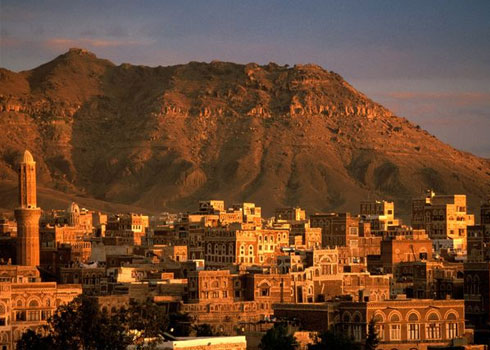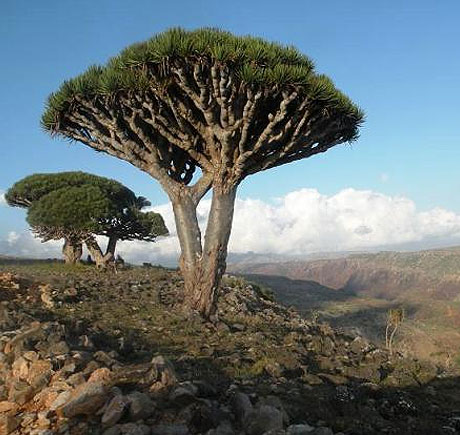Yemen
Country statistics

Total area: 203,849 sq miles (527,969 sq km)
Population (2010 est.): 23,495,361 (growth rate: 2.7%); birth rate: 34.3/1000; infant mortality rate: 56.7/1000; life expectancy: 63.4; density per sq miles: 109
Capital City: Sanaá
Monetary unit: Rial
Languages: Arabic
Ethnicity/race: predominantly Arab; but also Afro-Arab, South Asians, Europeans
Religions: Islam (including Sunni and Shiite), small numbers of Jewish, Christian, and Hindu
Country introduction

Yemen is in the Middle East, in the south of the Arabian Peninsula, bordering the Arabian Sea, Gulf of Aden, and Red Sea. It is west of Oman and south of Saudi Arabia.
A number of Red Sea islands, including the Hanish Islands, Kamaran and Perim, as well as Socotra in the Arabian Sea belong to Yemen. Many of the islands are volcanic; for example Jabal al-Tair had a volcanic eruption in 2007 and before that in 1883.
The country can be divided geographically into four main regions; the coastal plains in the west, the western highlands, the eastern highlands, and the Rub al Khali in the east.
The Tihamah, a semidesert coastal plain form at nearly 419 km (260 miles) long, has a very arid and flat surface that runs along the Red Sea. Despite the aridity, the presence of many lagoons makes this region very marshy and a suitable breeding ground for malarial mosquitoes. There are extensive crescent-shaped sand dunes. The evaporation in the Tihama is so great that streams from the highlands never reach the sea, but they do contribute to extensive groundwater reserves. Today, these are heavily exploited for agricultural use. Near the village of Madar about 48 km (29 miles) north of Sanaa, dinosaur footprints were found, indicating that the area was once a mud flat. The interior mountains have elevations ranging from a few hundred meters to the country's highest point, Jabal an Nabi Shuayb, which is 3,666 m (12,027 ft) above sea level.
The Tihamah ends abruptly at the escarpment of the western highlands that have an extensive high plateau over 2,000 m (6,561 ft) in elevation. This area, now heavily terraced to meet the demand for food, receives the highest rainfall in Arabia, rapidly increasing from 100 mm per year to about 760 mm in Ta'izz and over 1,000 mm in Ibb. Agriculture here is very diverse, with such crops as sorghum dominating. Cotton and many fruit trees are also grown, with mangoes being the most valuable. Temperatures are hot in the day but fall dramatically at night. There are perennial streams in the highlands but these never reach the sea because of high evaporation in the Tihama.
The highland regions are interspersed with wadis, or river valleys, that are dry in the summer months. Most notable is the Wadi Hadhramaut in eastern Yemen, the upper portions of which contain alluvial soil and floodwaters and the lower portion of which is barren and largely uninhabited. Both the eastern plateau region and the desert in the north are hot and dry with little vegetation.
The Rub al Khali in the east is much lower, generally below 1,000 m (3,280 ft), and receives almost no rain. It is populated only by Bedouin herders of camels.
The culture

In contrast to other people of the Arabian Peninsula who have historically led a nomadic or semi-nomadic existence, Yemeni people have tended to stay in one place. They generally live in small villages and towns scattered throughout the highlands and coastal regions. The Yemeni Jews have once formed a sizeable Jewish minority in Yemen with a distinctive culture. Today this community has reduced to only a few hundred individuals, following the Jewish exodus from Arab lands. There is a distinct tribal identity particularly in the northern regions of Yemen. Sheikhs are recognized as the tribal leaders in these areas and consider themselves responsible for resolving conflicts and public disputes between villagers.
The most important event a foreigner is likely to encounter in Yemen is Ramadan, the holy month of fasting. During this time all Muslims abstain from food, drinking, smoking, and sexual activity during daylight hours. As the Islamic calendar is a lunar calendar, the time of Ramadan falls eleven days earlier each successive year. The evening brings celebrations and the breaking of the fast, known as iftar; the feasting and merry-making often lasts until dawn. Although non-Muslims are not required to observe the fast, eating, drinking, and smoking around those who do is inconsiderate. At the beginning and conclusion of Ramadan, small gifts may be given to children. It is also appropriate for invited guests to bring gifts of sweets to families for iftar.
Weddings are joyous occasions in Yemen and one should feel honored if invited. Parties for men and women are almost always held separately, and generally speaking, members of one sex are not invited to the other sex's ceremonies. Both parties usually consist of an afternoon spent socializing with the bride or groom in their home. Afterwards, their friends gather to sing religious songs, songs in praise of the bride or groom and his/her family, and to dance. Just as Yemenis will arrive for the wedding clothed in their finest attire, foreign guests should do likewise with dress from Yemen or their country of origin.
Chewing Qat, has been around for hundreds of years in the impoverished nation of Yemen, where it is estimated that 70% of men, and about one in four women, habitually chew the plant daily. Qat is a leafy shrub containing an amphetamine compound that when chewed creates a mild buzz somewhere between caffeine and cocaine. The leaves are chewed and stored in the cheek where they break down in the saliva and the juices eventually enter the bloodstream.
Yemen's location and historical role as a cross roads between many cultures has created a musical tradition that is as rich and varied as the peoples who have contributed to it. Yemeni, in turn, has great influence over the musical traditions of the Arabia, Africa and Indonesia. The most significant individual style of art music in Yemen is based closely on poetry, including both classical Arabic poetry as well as that of Yemeni poets over the past centuries and up to today. Performance style consists of a solo singer with accompaniment (typically 'ud). Along with the basic combination of voice and 'ud, there can be percussion instruments to highlight the rhythms in subtly expressive ways. Many variants on this style exist in Yemen, and as a historical form, this was the specifically Arabic musical style which first made a world impact during the early Islamic Empire. The styles in Yemen are especially fluid in rhythm, with a wide variety of metrical patterns derived from poetic language, and articulated without strong rhythmic accents.
Yemeni food is strongly influenced by the Turkish, Indian and Arab cuisine. Chicken and lamb are eaten more often than beef, which is expensive. Fish is also eaten, especially in the coastal areas. Cheese, butter, and other dairy products are less common in the Yemeni diet. Buttermilk is enjoyed almost daily in some villages where it is most available. The most commonly used lipids are vegetable oil and ghee used in savory dishes, and clarified butter, known as semn used in pastries.
Attractions & landmarks

The variety of civilisations and cultures that have occupied the country over the years have made it one of the Middle East's most interesting and attractive tourist destination.
Sana'a, the capital of Yemen, is a 2,500 year old city that many say has barely changed in appearance for nearly an entire century. It is a major tourist destination in the country, famous for its beautiful age old fortifications. The city is home to beautiful mosques inscribed with quotes from the Holy Quran. The city is home to the Great Mosque of Sana'a, the National Museum and the famous Sana'a souk.
Sa'dah, the northernmost major town in Yemen, boasts a large collection of ancient drawings and texts that were written by nomadic tribes dating back to about 4,500 years ago. Wandering about these canyons and caves today, a visitor can see renderings of rams and ibex, of goats, hounds, and snakes, of people and cattle, plants and geometrical shapes, and inscriptions in Sabaean letters. These petroglyphs, some of the oldest rock art in Arabia, have been beautifully preserved by the desert climate.
Aden situated by the Arabian Sea, is the country's popular coastal city and was the former capital of the old South Yemen. Here, visitors will find some fine beaches set amid stunning scenery with the islands of the Red Sea in one direction and rolling valleys in another. Opportunities for visitors to go scuba diving in the Red Sea are plentiful with week-long trips available giving true underwater enthusiasts the experience of a lifetime. Two of the most vital historical landmarks are the Water Reservoirs of Al-Taweelah and the Fort of Jabal 'Aly. Most of the monuments are situated in the Old city of Aden and the surrounding area.
Ta'izz city is one of the upcoming tourist spots in Yemen, located 256 km (159 miles) from Sana'a. Towering above Ta'izz is the 3,000m (10,000 foot) Jabal Sabir, which is known all around Yemen for its dazzling ascent and view from the top. This mountain is very fertile and is home to tens of thousands of people living on and around the mountain. Landmarks in the city include the Al Ma'tabiyyah dome and the Al Muzaffar mosque. There is also a museum housing artifacts and relics.
Al Mocha, a port city on the Red Sea coast, located 94 km (58 miles) west to Ta'izz is famous for being the major marketplace for coffee from the 15th century until the 17th century. Because the Arabs controlled the coffee trade through Al Mocha, the name "mocha" became synonymous with coffee, and even today it is the word for the chocolate-flavored variant. Al Mocha is also well known for its beautiful scenery. Particularly striking are the beaches at Yakhtal and Malik. There are also several palm trees around the city.

Socotra, off the south coast of Yemen is an idylic island untouched by modern man. The seas are turquoise blue and the sands white and unspoiled. The coral reefs of Socotra are diverse, with many endemic species. It is considered one of the most valuable islands on the planet, often described as the most alien-looking place on Earth. Its beaches resemble those of the Caribbean and its mountains are covered with many rare species and plants that can only be found in Socotra. These include a centipede that eats flesh as well as a myriad of reptiles and birds. There are also the Dragon's Blood trees, which is a strange-looking, umbrella-shaped tree. Its red sap was thought to be the dragon's blood of the ancients.
Socotra is also renowned as one of the main producers of frankincense and myrrh, incenses that burned in the ancient temples of Egypt and Greece, and are still used in ceremonies throughout the world today. The ancient Incense Road began at the port of Qana on the Arabian Sea, and transported the famed fragrances as far as Gaza on the Mediterranean. The trade played a great role in the foundation of the Minaean Kingdom, one the most powerful realms during the first millennium BC, which was succeeded by the Sabaeans, from the area known in the Bible as Sheba.